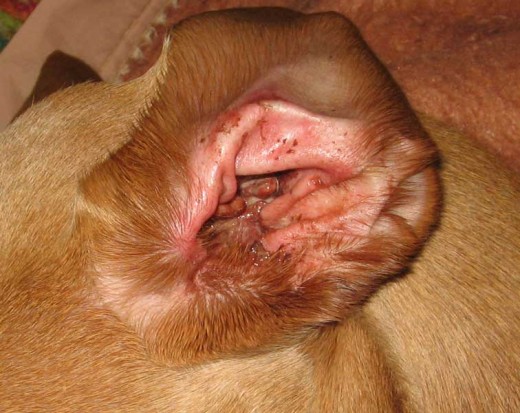Right now the best luck I’m having with ear infections is with Claro. I’ve got information about that in my web site, and at my clinic. Below is a downloadable document that explains Claro in detail.
Ear Troubles
In this document, I will discuss the different ear problems I see, and some of the treatments and diagnostic tools I have available to bring the speediest recovery at the most reasonable cost.
One of the best combinations I have used has been OTOMAX twice a day x 7 days THEN BuroCort (Burow’s) every 24 hours x 7 days then continue BuroCort twice a week for maintenence.
When a dog or cat has an ear problem, a certain list of problems can be considered as common causes.
Dogs:
~Water in the ear causes bacterial overgrowth, rusty yeast infections, and inflammation.
~Allergies (ATOPY) can extend into the ear causing redness and scratching.
~Occasionally, ear mites can live in dogs’ ears.
~Often, in concert with a bacterial infection, a yeast can set up in an ear, causing it to become chronic. Swelling, redness and ITCHING are hallmarks of a yeast infection in canine ears.
Cats:
~Earmites frequently are the cause of ear trouble in cats.
~Secondly, would be bacterial infection.
When examining an animal’s ear, I look to see if it appears to be a mite problem, (ear mites) and if I suspect it is so, I’ll take a swabbing of the wax in the ear and look at it under the microscope. If mites are found, treatment is started immediately.
I will check the ears very well with an instrument called an Otoscope, and if the Otoscopic examination yields the diagnosis, a treatment is started to bring the pet much needed relief. In some cases, cultures of a chronically infected ear may be required.
Treatments may include any of the following: An injection of an anti-inflammatory drug, ear medication such as Otomax®, oral antibiotics, or in some cases, ear mite treatments of a variety of kinds. Depending upon how many, or how few of these treatments it takes to bring about a cure of the ear problem, will determine how much is spent on the problem. Obviously, if you are within a budget, you would need to talk frankly with me about these limitations. I’m great at getting good results within most any budget.
The most important thing is to treat for the full treatment period and bring the pet back at the conclusion of the medications prescribed. There is rarely a nominal re-examination fee at that time. But it is ultimately important that no remnant of infection be allowed to remain in the ear, or the problem will come back to haunt you.
FAVORITE MEDICATIONS:
Tresaderm – Non occlusive and thin, this has marvelous penetration and kills ear mites as well as a variety of bacteria, yeasts, and fungi.
Otomax – Best first choice medication where redness and pain are the hallmarks. This medicine is simple to use once per day and requires no refrigeration. Interestingly, when this medication rarely does have a failure, Tresaderm proves to be often curative.
DO NOT USE: Water based Chlorhexidine ear cleaners. They leave water in the ear. Clean ears with modest mounts of mineral oil on a cotton ball, or for really gruesome ears, irrigate with soap and water and then apply one of the above medications to displace residual water.






